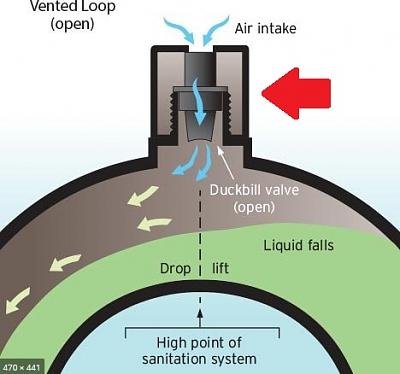On November 1, 2020, I last saw my boat, as I had returned Retreat to her winter residence on Vancouver. All was well. Fuel and water were full, Black water was empty, she was plugged in with heaters on the lowest settings. Charger and water heater on in the ER to keep that area warm.
What could fail?
This morning I made the trek to remove Retreat from that winter moorage and bring her home to Saltspring. Beautiful warm, sunny, calm day. Perect for a crossing of Georgia Strait.
On boarding, I could hear water running. I checked the bilge in the forward cabin. nice and dry, but the sound of running water was louder. I checked the ER. Not as loud, and no sign of high water. I then checked the galley. The floor opens above the holding tank. All the fittings are right there, and the vent line had parted just after the hose clamps. A stream of water was draining from the top of the tank to the bilge. But I had left the tank empty???
I didn't take long to decide that the anti siphon had failed. I had recently renewed those hoses and the anti siphon, with one like this: https://www.ebay.ca/sch/i.html?_nkw...pe=e&msclkid=f6640a44b88d1cbd7e2a6a39bdee1656
from the top of the fitting, a lightweight hose drains any spittle into the bilge. I blew on that hose and couldn't get any air to pass through it. SO I took it off and used a coat hanger to poke through the blockage and open it up, then ran the pump and noted a good strong stream. All good now.
Before putting in the new hose and siphon break, I had never had such a failure. There are other, older siphon breaks aboard, all of which are performing properly. This one is now add as the regular maintenance item.
What could fail?
This morning I made the trek to remove Retreat from that winter moorage and bring her home to Saltspring. Beautiful warm, sunny, calm day. Perect for a crossing of Georgia Strait.
On boarding, I could hear water running. I checked the bilge in the forward cabin. nice and dry, but the sound of running water was louder. I checked the ER. Not as loud, and no sign of high water. I then checked the galley. The floor opens above the holding tank. All the fittings are right there, and the vent line had parted just after the hose clamps. A stream of water was draining from the top of the tank to the bilge. But I had left the tank empty???
I didn't take long to decide that the anti siphon had failed. I had recently renewed those hoses and the anti siphon, with one like this: https://www.ebay.ca/sch/i.html?_nkw...pe=e&msclkid=f6640a44b88d1cbd7e2a6a39bdee1656
from the top of the fitting, a lightweight hose drains any spittle into the bilge. I blew on that hose and couldn't get any air to pass through it. SO I took it off and used a coat hanger to poke through the blockage and open it up, then ran the pump and noted a good strong stream. All good now.
Before putting in the new hose and siphon break, I had never had such a failure. There are other, older siphon breaks aboard, all of which are performing properly. This one is now add as the regular maintenance item.

